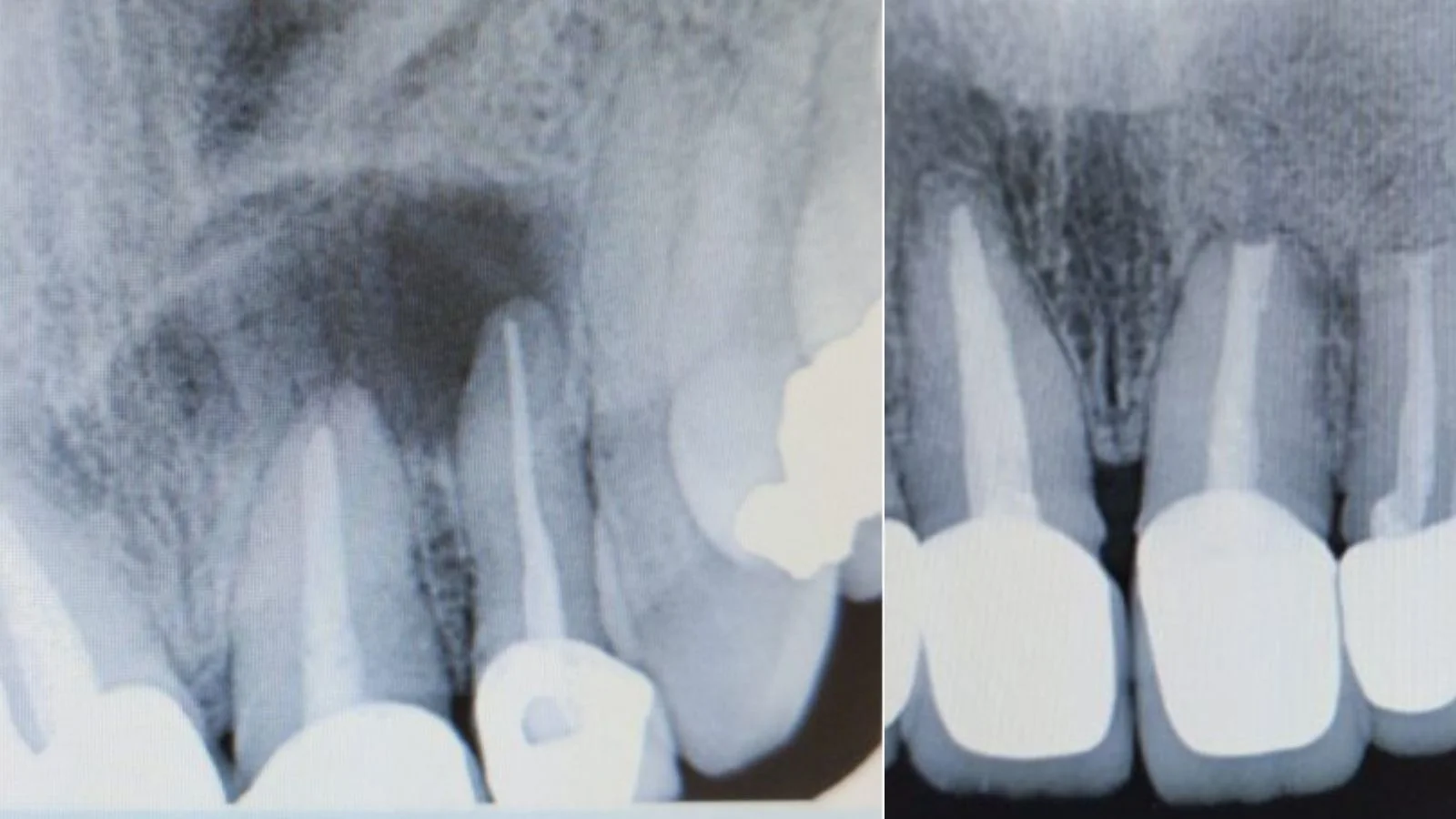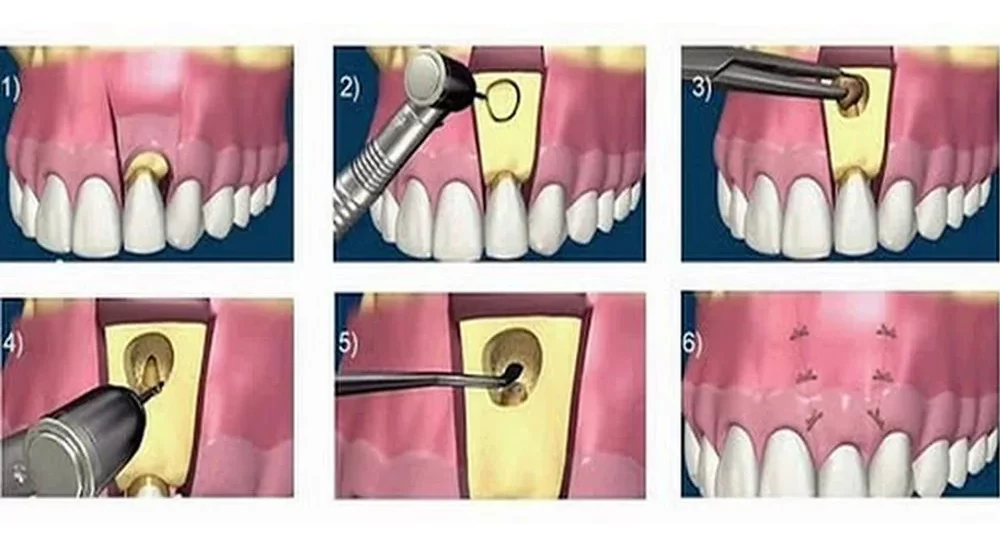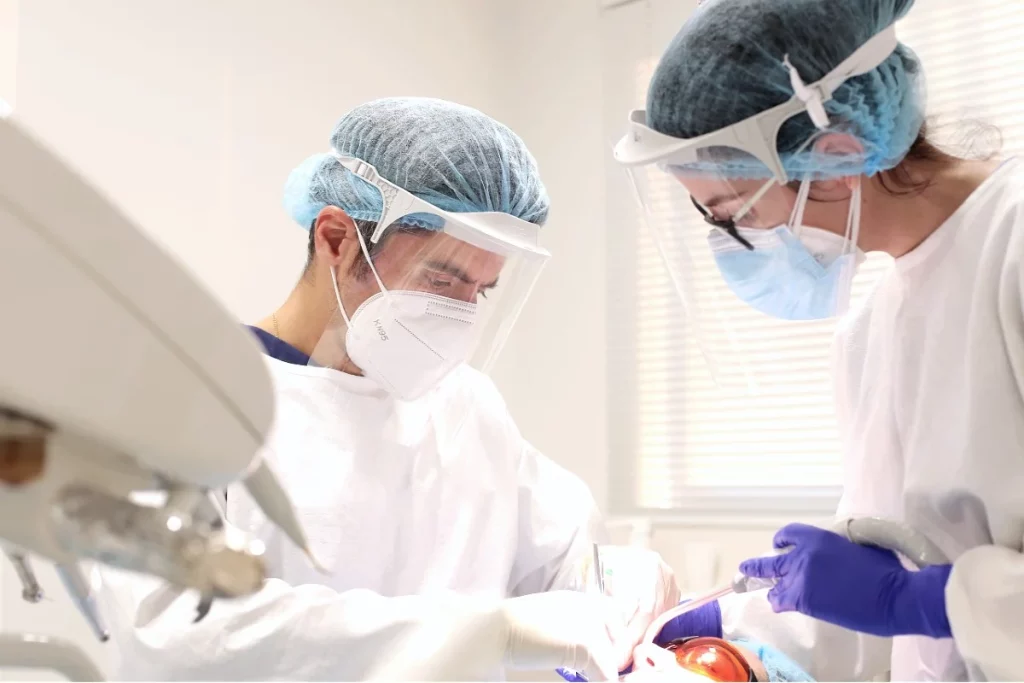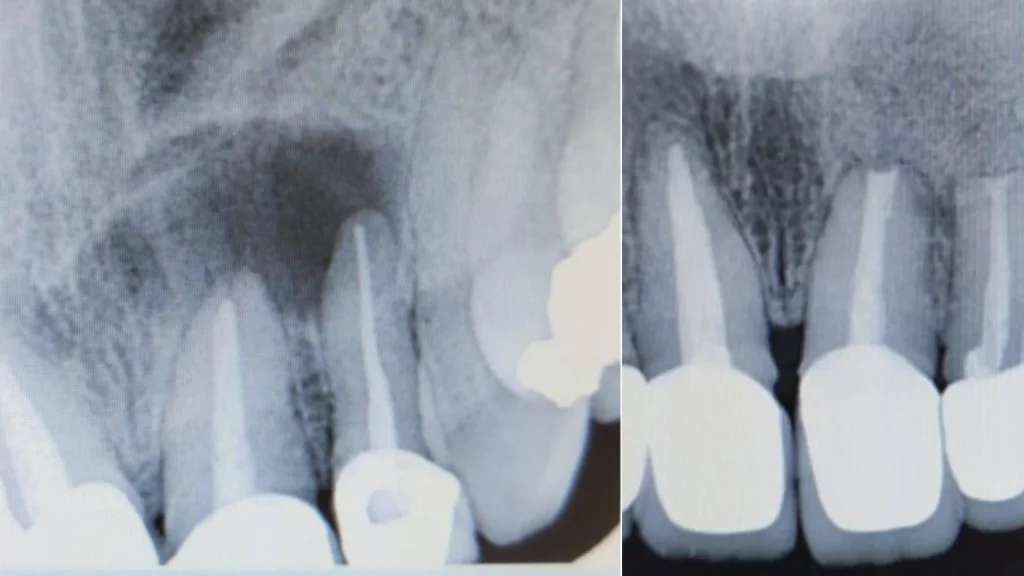Last Updated on: 12th December 2025, 06:03 am
All about Apicoectomy: A Key Procedure in Dental Health
When it comes to preserving an infected tooth, endodontics is often the treatment of choice. However, on certain occasions, this procedure is not enough, and it is necessary to opt for a dental apicoectomy.
Dentists resort to this minor surgery to avoid removing the infected tooth. In situations where root canal treatments have not been successful, this technique allows the infected tissue to be removed, making it possible to preserve the tooth.
An apicoectomy, a term not so familiar outside the dental field, represents a crucial solution for certain dental problems that go beyond what conventional treatment can solve. This article will go into more detail about what an apicoectomy entails when it is necessary, how it is performed, and what to expect after the procedure.
What is an Apicoectomy?
In simple terms, an apicoectomy is an endodontic surgical procedure that involves the removal of the root tip of a tooth and the surrounding infected tissue. It is distinct from other dental treatments because of its surgical nature and that it focuses on cases where large periapical areas are infected. This intervention allows us to eradicate infections still present after a root canal treatment.
Thus, residual discomfort from endodontics is relieved, and future complications are avoided. The need to extract the tooth is also prevented, allowing it to continue performing its normal functions in the mouth.
Cases in which an Apicoectomy is Recommended
An apicoectomy is recommended when there are long-term problems in an endodontically treated tooth, and conventional non-surgical treatment is not sufficient. This may include cases of deep cavities, trauma, and bacterial infections, among others.
The apicoectomy process
The process of an apicoectomy includes administering local anesthesia, followed by cleaning the infection from the bone, removing and eliminating a small portion of the infected tissue at the tip of the tooth root, and then sealing the end of the root with a small filling to prevent future infections.
It is necessary to make an incision in the gum over the root of the tooth or around the gingival edge of several teeth. The gum is then lifted to access the bone. The infected area is reached by removing a small amount of bone above it with a drill.
Any infected tissue is carefully cleaned before a portion of the root tip is removed. The root end is then sealed with a small filling. The gum is sutured back into place with dissolvable stitches that usually disappear in about two weeks. However, the dentist or surgeon may decide to remove them sooner. Depending upon the intervention and the complexity of the case, these types of treatments usually last between 30 and 90 minutes.
In some offices, surgical microscopes allow a more precise approach.
What kind of anesthesia is used?
Typically, apicoectomy is performed under local anesthesia, which involves an injection into the gum to numb the area. This type of anesthesia prevents the sensation of pain during the procedure. If you feel particularly anxious, your surgeon may suggest some type of sedation.
In cases where the infection around the root is extensive or there is a large cyst around the root – or if several teeth need to be operated on – it may be necessary to resort to general anesthesia.
Recovery and Postoperative Care
After the procedure, the specialist may prescribe medications and give specific instructions for home care, including brushing techniques and dietary restrictions.
Once the effect of the local anesthesia wears off, a few hours after surgery, it is normal to experience some discomfort. If significant pain is anticipated, your surgeon will recommend pain relievers.
Additionally, it may be necessary to start treatment with antibiotics. The discomfort tends to intensify during the first few days and may take up to a couple of weeks to completely disappear. You may need to take a day or two off work, during which time you should avoid heavy exercise.
After surgery, you may experience pain and swelling both inside and outside your mouth; it usually subsides within a day or two. It is crucial to keep the operated area as clean as possible during the first postoperative weeks. If brushing is difficult, you can keep the area free of food residue by rinsing gently with a mouthwash or warm salt water (dissolve a teaspoon of kitchen salt in a cup of warm water), starting the day after the operation.
Oral care after an apicoectomy
Although most patients return to their normal activities days after an apicoectomy, it is important to follow certain recommendations to promote recovery:
● Opt for a soft and cold diet during the first days.
● Apply cold compresses to the operated area to reduce inflammation.
● Clean the mouth gently, avoiding directly brushing the treated area.
● Use mouthwashes or gels with chlorhexidine from the day after surgery, if the dentist indicates it.
● Keep your head in an elevated position when resting.
● Refrain from sports activities or intense exercises.
● Avoid smoking and consuming alcohol.
Possible Complications
Complications after a dental apicoectomy are usually rare. For the most part, it is a highly successful procedure that relieves the symptoms and discomfort associated with dental infection.
Although apicectomies are generally safe, there are risks of postoperative complications or nerve damage. It is crucial to follow your doctor’s instructions and watch for any signs of infection or delayed healing.
According to a 2020 study, approximately 97% of patients undergoing apical surgeries reported excellent results up to five years after the procedure. Even further, in the range of 10 to 13 years, positive results were maintained in more than 75% of cases.
Postoperative bleeding is rare; but if it does occur, it can usually be controlled by applying pressure to the area with a tissue or swab for ten minutes. If bleeding persists, contact a specialist. It is recommended to avoid smoking after surgery, as it increases the risk of infection, especially with oral surgical procedures.
There may be temporary numbness in the gum due to lifting it to access the root of the tooth, usually disappearing within a few months. Additionally, the gum may recede slightly during healing. If the tooth has a crown, the edge of the crown may be exposed.
Although rare, the infection can recur months or years later, which may require repeat surgery or, in some cases, extraction of the tooth. According to reports, generally, the cause of failure or recurrence of infection is usually related to the presence of a space at the end of the root and a poor apical seal that favors the persistence and proliferation of bacteria.
Contraindications for this Procedure
Although there are situations in which apicoectomy is recommended, there are circumstances in which this procedure is not advisable. Some of the factors that contraindicate its performance include:
● Severe damage to the root of the tooth.
● Patients with blood coagulation disorders.
● Acute infections accompanied by intense bleeding.
● Teeth that present longitudinal fractures.
● Infections located near the maxillary sinus.
● Teeth with abnormal canals inaccessible to endodontic treatments.
● Advanced periodontal disease or significant loss of supporting bone.
Why is a Specialist Important?
Choosing a qualified and experienced endodontist is critical to the success of the procedure. The criteria for selecting a specialist should include their history, surgical skills, and knowledge of the subject.
Conclusion
In conclusion, a dental apicoectomy is an important and effective surgical procedure to treat persistent infections in the root of the tooth that cannot be resolved by conventional endodontic treatments. Although it is a safe treatment with a high success rate, it is crucial to take into account contraindications and postoperative care to ensure optimal recovery.
Careful oral hygiene, a proper diet, and avoiding certain habits such as tobacco and alcohol are essential for proper healing and to prevent complications. As always, it is advisable to follow the dentist’s specific instructions and attend post-operative check-ups to ensure the health and functionality of the treated tooth.
Frequently Asked Questions
How long does it take for complete healing after an apicoectomy?
External healing is generally complete in about two weeks. The sutures are usually removed between 7 and 15 days after the procedure, although if they are resorbable, they may disappear on their own within a period of 3 to 4 weeks. As for internal regeneration, such as bone regeneration, this process can last up to six months.
What is the purpose of performing an apicoectomy?
Apicoectomy is a surgical procedure used to treat an infection that affects the root of a tooth or nearby tissues. Infections in the mouth and teeth are common and are usually quite painful. Although these infections are common, it is not always necessary to resort to an apicoectomy to treat them.
What is the care after an apicoectomy?
It is essential to remember to keep your head in a somewhat elevated position when resting, using pillows for this purpose. In the days following the procedure, it is advisable to avoid direct brushing on the treated area during daily oral hygiene and add the use of antiseptic mouthwashes to your routine.
What is the best way to sleep after an apicoectomy?
When you go to sleep, be sure to elevate your head using several pillows or cushions. It is crucial to rest adequately and refrain from physical exercise. Avoid chewing with teeth close to the operated area and maintain a soft, cold diet for the first 24 hours after surgery.
Share:
References
1. University Hospitals Sussex NHS Foundation Trust. (May. 2021). Apicectomy. https://www.uhsussex.nhs.uk/wp-content/uploads/2022/09/Apicectomy.pdf
2. Cambridge University Hospitals. (Apr, 2022).Apicectomy (removal of root tip infection): FAQ. https://www.cuh.nhs.uk/patient-information/apicectomy-removal-of-root-tip-infection-faq/
3. Lopez, Simon; DDS. (Sep, 2022). Apicoectomy. When is it done and what is its recovery like? https://gacetadental.com/2022/09/apicectomia-cuando-se-realiza-y-como-es-su-recuperacion-33965/
4. Buffa, Vanesa; DDS. (Jul, 2023). Dental apicoectomy: what it is and what are its benefits. https://mejorconsalud.as.com/apicectomia-dental-beneficios/
5. Lio, F., Mampieri, G., Mazzetti, V., Leggeri, A., & Arcuri, L. (2021). Guided endodontic microsurgery in apicoectomy: a review. Journal of Biological Regulators and Homeostatic Agents, 35(3 Suppl. 1), 47-55.
6. Gómez-Carrillo, Víctor, Giner Díaz, Jorge, Maniegas Lozano, Lourdes, Gaite Ballesta, Juan José, Castro Bustamante, Alfredo, Ruiz Cruz, José Alfonso, & Montesdeoca García, Néstor. (2011). Surgical apicoectomy: proposal for an evidence-based protocol. Spanish Journal of Oral and Maxillofacial Surgery, 33(2), 61-66. Retrieved on November 29, 2023, from http://scielo.isciii.es/scielo.php?script=sci_arttext&pid=S1130-05582011000200002&lng=es&tlng=es.
-
Nayibe Cubillos M. [Author]
Pharmaceutical Chemestry |Pharmaceutical Process Management | Pharmaceutical Care | Pharmaceutical Services Audit | Pharmaceutical Services Process Consulting | Content Project Manager | SEO Knowledge | Content Writer | Leadership | Scrum Master
View all posts
A healthcare writer with a solid background in pharmaceutical chemistry and a thorough understanding of Colombian regulatory processes and comprehensive sector management, she has significant experience coordinating and leading multidisciplina...




















